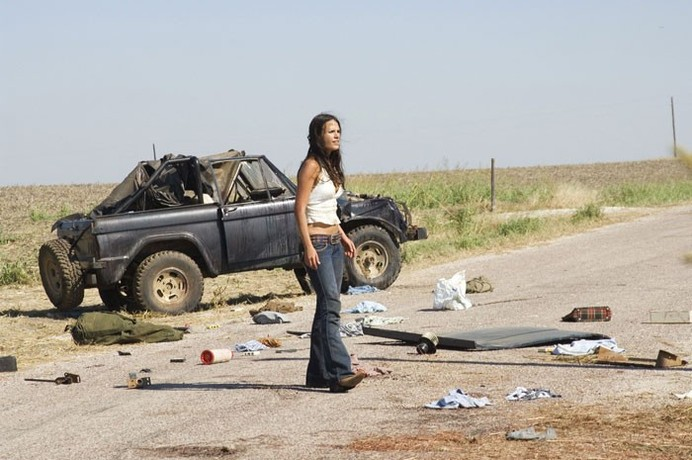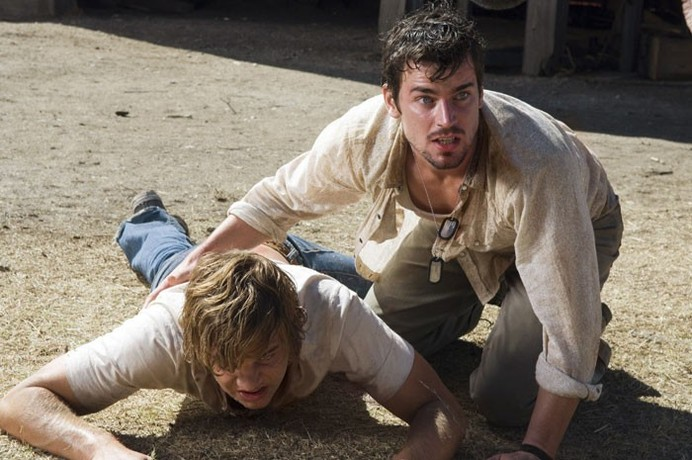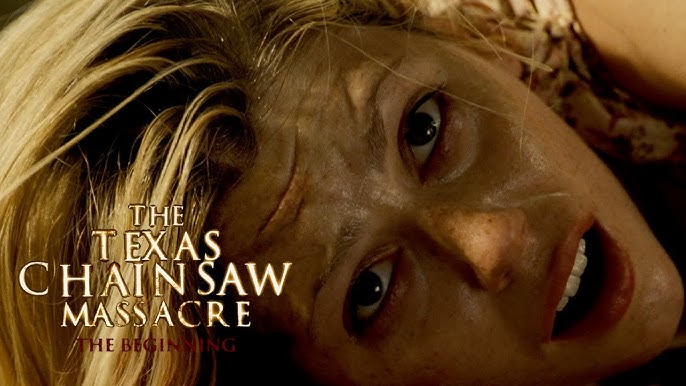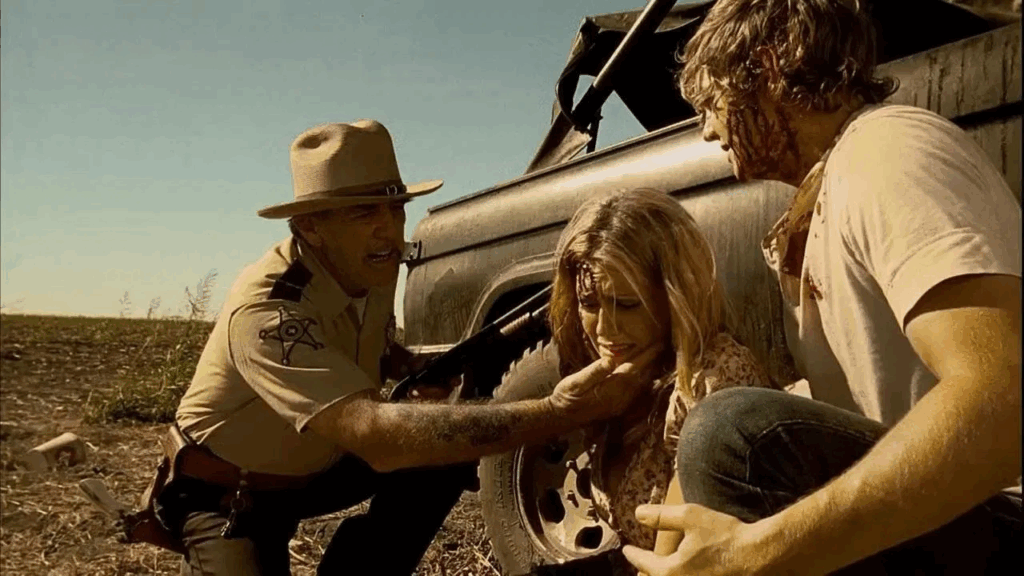Massacre Texas 2006

The Texas Chainsaw Massacre: The Beginning (2006): A Comprehensive Guide to a Gory Prequel
Released on October 6, 2006, The Texas Chainsaw Massacre: The Beginning is a prequel to the 2003 remake of Tobe Hooper’s 1974 horror classic, The Texas Chain Saw Massacre. Directed by Jonathan Liebesman and produced by Michael Bay’s Platinum Dunes, this brutal slasher film delves into the origins of the iconic killer Leatherface and his cannibalistic Hewitt family. Starring Jordana Brewster, Taylor Handley, Diora Baird, Matt Bomer, and R. Lee Ermey, the movie takes viewers back to 1969, exploring the gruesome beginnings of one of horror’s most infamous franchises. While it didn’t match the financial success of its 2003 predecessor, grossing $51.8 million worldwide against a $16 million budget, it remains a polarizing yet compelling entry for gore enthusiasts. This article provides a comprehensive overview of The Texas Chainsaw Massacre: The Beginning, covering its plot, themes, cast, production, reception, and legacy, while addressing its place in the franchise’s convoluted timeline.

Plot Summary
Set in 1969, The Texas Chainsaw Massacre: The Beginning serves as a prequel to the 2003 remake, revealing the origins of Thomas Hewitt, aka Leatherface, and his deranged family. The film opens in 1939 at a Texas slaughterhouse, where a worker dies during a botched abortion, leaving her deformed baby abandoned in a dumpster. A beggar, Luda Mae Hewitt (Marietta Marich), finds the child and raises him as Thomas (Andrew Bryniarski), who grows up with a facial deformity and a penchant for violence. By 1969, Thomas works at the slaughterhouse, but when it shuts down, he murders his boss, marking his descent into madness.
Meanwhile, brothers Eric (Matt Bomer) and Dean (Taylor Handley), drafted for the Vietnam War, embark on a final road trip with their girlfriends, Chrissie (Jordana Brewster) and Bailey (Diora Baird). After a run-in with bikers leads to a car accident, the group is “rescued” by Sheriff Hoyt (R. Lee Ermey), who is actually Charlie Hewitt, Thomas’s stepfather, posing as law enforcement after killing the real sheriff. Hoyt takes the teens to the Hewitt family’s decrepit farmhouse, where they become victims of the family’s sadistic rituals.
The narrative unfolds as a relentless descent into horror, with Thomas crafting his first human-skin mask and committing his initial chainsaw murder, earning the name Leatherface. The Hewitts—Luda Mae, Hoyt, Monty (Terrence Evans), and Henrietta (Heather Kafka)—torture and kill the teens, with Chrissie’s desperate attempts to save her friends driving the suspense. The film’s grim tone, punctuated by visceral gore, culminates in a bleak ending, narrated by an uncredited John Larroquette, who frames the Hewitts’ crimes as an ongoing nightmare.

Themes and Analysis
The Texas Chainsaw Massacre: The Beginning amplifies the franchise’s core themes of depravity, family dysfunction, and societal decay, while introducing new layers specific to its prequel status. Key themes include:
- Origins of Evil: The film seeks to explain Leatherface’s transformation into a monster, attributing it to his physical deformity, abusive upbringing, and the Hewitt family’s influence. Thomas’s skin disease, which rots his nose, motivates his mask-making, while his slaughterhouse environment normalizes violence. Critics argue this backstory humanizes Leatherface too much, reducing his mystique compared to the enigmatic terror of the 1974 original.
- Family and Control: The Hewitt family, renamed from the Sawyer clan of the original, is a twisted parody of domesticity. Hoyt’s authoritarian rule, Luda Mae’s maternal devotion, and Thomas’s loyalty reflect a perverse family dynamic, where cannibalism and murder are rituals of unity. The film contrasts this with the teens’ bond, highlighting selfless acts like Chrissie’s rescue attempt and Eric’s sacrifice for Dean.
- Vietnam War Context: Set in 1969, the film subtly nods to the era’s turmoil, with Eric and Dean’s draft notices symbolizing a loss of innocence. The Hewitts’ brutality mirrors the era’s violence, though the film prioritizes gore over political commentary, unlike the 1974 original’s critique of Nixon-era anxieties.
- Slasher Tropes and Nihilism: The movie embraces slasher clichés—isolated setting, predictable kills, and characters making poor decisions—while pushing nihilistic violence. Its relentless grimness, with no humor or hope, distinguishes it from other franchise entries but alienates viewers seeking nuance.
Critics note its similarity to the 2003 remake, reusing locations and plot beats, which some see as a lack of originality. However, its unflinching gore and R. Lee Ermey’s chilling performance as Hoyt add a raw intensity that resonates with horror fans.

Cast and Characters
The film’s cast, blending rising stars and genre veterans, delivers solid performances despite the script’s focus on violence over character depth:
- Andrew Bryniarski as Thomas Hewitt/Leatherface: Reprising his role from the 2003 remake, Bryniarski portrays a younger, less experienced Leatherface. His hulking presence and silent menace anchor the film, though the backstory softens his terror.
- R. Lee Ermey as Sheriff Hoyt/Charlie Hewitt: Ermey steals the show as the sadistic patriarch, delivering a commanding, unhinged performance. His portrayal of Hoyt as both sheriff and mastermind elevates the film, with critics praising his ability to make the character both terrifying and darkly charismatic.
- Jordana Brewster as Chrissie: Known for The Fast and the Furious, Brewster plays the resourceful final girl, whose bravery and desperation drive the narrative. Her performance adds emotional weight to the relentless horror.
- Taylor Handley as Dean and Matt Bomer as Eric: Handley and Bomer, the latter before his White Collar fame, portray the brothers with convincing chemistry. Their sacrifices highlight the film’s rare moments of heroism.
- Diora Baird as Bailey: Baird’s role is limited, but her character’s vulnerability amplifies the Hewitts’ cruelty. Supporting roles by Marietta Marich, Terrence Evans, and Heather Kafka flesh out the grotesque Hewitt clan.
The cast’s commitment, particularly Ermey’s, compensates for the script’s thin characterizations, making the film’s violence more impactful.

Production and Filming
Directed by Jonathan Liebesman (Wrath of the Titans), The Texas Chainsaw Massacre: The Beginning was written by Sheldon Turner and David J. Schow, with Michael Bay, Tobe Hooper, and Kim Henkel as producers. Filmed in Texas, primarily in Martindale, Manor, Granger, and Johnson City, the production reused locations from the 2003 remake, including the Hewitt house (901 County Rd. 336, Granger) and Lee Bros. Meats (204 Main St., Martindale) for Leatherface’s basement. The Cele Store in Manor served as the gas station, and a motel in Johnson City appeared early in the film.
The film’s $16 million budget, higher than the 2003 remake’s $9.5 million, allowed for polished production values, with cinematographer Lukas Ettlin capturing a gritty, sepia-toned aesthetic. Special effects, emphasizing practical gore, were a highlight, with realistic blood and dismemberment satisfying horror fans. The UK version, reportedly eight minutes longer than the US cut, included additional violence, suggesting MPAA edits for the R rating. Steve Jablonsky’s score heightened the tension, complementing the film’s relentless pace.
Production faced challenges, including the Texas heat, which echoed the grueling conditions of the 1974 original. Liebesman aimed to honor the franchise while delivering a standalone prequel, though some felt the film leaned too heavily on the 2003 remake’s template.

Reception and Legacy
The Texas Chainsaw Massacre: The Beginning received largely negative reviews, earning a 15% approval rating on Rotten Tomatoes from 87 reviews, with an average score of 3.8/10. Critics praised its gore and Ermey’s performance but criticized its predictability, lack of scares, and overreliance on violence over storytelling. The New York Times called it “a poisonous prequel” that prioritizes “blood-sodden visuals” over substance, while Variety noted its “jaunty pace” but decried its nihilism. It was nominated for a 2007 Golden Raspberry Award for Worst Prequel or Sequel, reflecting its critical drubbing.
Audience reception was mixed. Horror fans, particularly gore enthusiasts, appreciated its intensity, with one IMDb reviewer calling it “relentless” and deserving of the franchise’s name. Others found it “disturbing” rather than scary, criticizing its weak plot and cliché-ridden script. On IMDb, it holds a 5.8/10 rating from 78,000 votes, indicating a divide between genre devotees and casual viewers.
Box office performance was modest, with $39.5 million domestically and $51.8 million worldwide, a significant drop from the 2003 remake’s $107 million. The decline, coupled with poor reviews, paused the franchise until Texas Chainsaw 3D in 2013, which ignored this timeline. Despite its commercial underperformance, the film’s home video release on January 16, 2007, bolstered its cult following, particularly among fans of the 2003-2006 duology.
The film’s legacy lies in its attempt to expand Leatherface’s mythology, though many argue it demystified the character. Its influence is seen in the 2000s trend of horror prequels (Halloween, The Amityville Horror), but it’s often ranked low in the franchise, with outlets like Vulture and Entertainment Weekly placing it near the bottom for its lack of innovation. Still, its visceral gore and Ermey’s iconic performance keep it relevant for horror completists.

Franchise Context and Timeline
The Texas Chainsaw Massacre: The Beginning is the sixth film in the franchise and forms a standalone timeline with the 2003 remake. The franchise, spanning nine films, is notoriously convoluted, with multiple reboots, sequels, and prequels:
- Original Timeline: The Texas Chain Saw Massacre (1974), The Texas Chainsaw Massacre 2 (1986), Leatherface: The Texas Chainsaw Massacre III (1990), Texas Chainsaw Massacre: The Next Generation (1995).
- Remake Timeline: The Texas Chainsaw Massacre (2003), The Texas Chainsaw Massacre: The Beginning (2006).
- Alternate Timelines: Texas Chainsaw 3D (2013, direct sequel to 1974), Leatherface (2017, prequel to 1974), Texas Chainsaw Massacre (2022, sequel to 1974).
This film introduces the Hewitt family, replacing the Sawyer clan, and gives Leatherface the name Thomas Hewitt, with a skin disease explaining his masks. Unlike the 1974 original, loosely inspired by Ed Gein, this prequel invents a fictional backstory, diverging from real-life influences. Its place in the remake timeline makes it essential for fans of the 2003 film but irrelevant to later entries.

Where to Watch and Cultural Impact
The Texas Chainsaw Massacre: The Beginning is available on platforms like Apple TV, Amazon Prime Video, and Fandango at Home for rent or purchase. Physical copies are accessible on DVD and Blu-ray via retailers like Amazon. It’s not currently streaming on major subscription services like Netflix or Peacock, but availability may vary by region.
Culturally, the film reflects the 2000s horror remake boom, driven by the 2003 remake’s success. Its graphic violence, enabled by relaxed MPAA standards post-Saw and Hostel, catered to audiences craving extreme horror. However, its critical failure highlighted the risks of over-explaining iconic villains, a lesson echoed in later prequels like Leatherface (2017). The film’s locations, like the Hewitt house, have become pilgrimage sites for horror fans, with photos shared on sites like Horror Explorer in 2024.
Social media sentiment, such as a 2022 post from @GQMexico, emphasizes its premise of a road trip gone wrong, resonating with fans of classic slasher tropes. While not a cultural touchstone like the 1974 original, it remains a notable entry for its unrelenting intensity and franchise loyalty.

Conclusion
The Texas Chainsaw Massacre: The Beginning is a polarizing chapter in the Texas Chainsaw Massacre saga, delivering visceral gore and a chilling performance by R. Lee Ermey but stumbling with a predictable plot and excessive nihilism. As a prequel to the 2003 remake, it offers a grim origin story for Leatherface and the Hewitt family, set against the backdrop of 1969 Texas. Despite critical scorn and modest box office returns, its cult status endures among horror fans drawn to its brutal aesthetic and franchise connections. For those seeking a bloody, no-holds-barred slasher, it’s a worthy watch, though it pales beside the 1974 classic’s raw terror. Whether you’re a Texas Chainsaw completist or a gorehound, The Texas Chainsaw Massacre: The Beginning is a gruesome journey into the heart of horror’s most enduring nightmare.